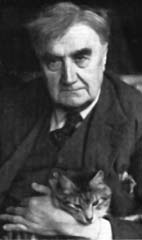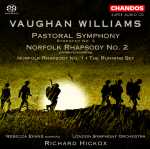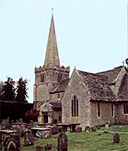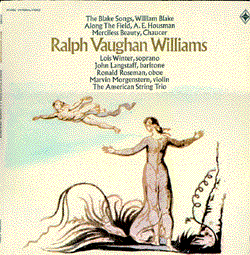|
The Lark Ascending Still

Ralph Vaughan Williams was born in Down Ampney, Gloucestershire,
on the 12 October 1872. He studied with Parry, Wood and Stanford at the RCM and Cambridge, then had further lessons with Bruch
in Berlin (1897) and Maurice Ravel in Paris (1908). It was only after this that he began to write with sureness in larger
forms, even though some songs had had success in the early years of the century. That success, and the ensuring maturity,
depended very much on his work with folksong, which he had begun to collect in 1903; this opened the way to the lyrical freshness
of the Housman cycle On Wenlock Edge and to the modally inflected tonality of the symphonic cycle that began with A Sea Symphony.
But he learnt the same lessons in studying earlier English music in his task as editor of the English Hymnal (1906) - work
which bore fruit in his Fantasia on a Theme by Tallis for strings, whose majestic unrelated consonances provided a new sound
and a new way into large-scale form. The sound, with its sense of natural objects seen in a transfigured light, placed Vaughan
Williams in a powerfully English visionary tradition, and made very plausible his association of his music with Blake (in
the ballet Job) and Bunyan (in the opera The Pilgrim's Progress). Menwhile the new command of form made possible a first orchestral
symphony,
A London Symphony, where characterful detail is worked into the scheme. A first opera, Hugh the Drover,
made direct use of folksongs, which Vaughan Williams normally did not do in his orchestral works.
His study of folksong,
however, certainly facilitated the pastoral tone of The Lark Ascending, for violin and orchestra, and then of the Pastoral
Symphony. At the beginning of the 1920s there followed a group of religious works continuing the visionary manner: the unaccompanied
Mass in g Minor, the Revelation oratorio Sancta civitas and the 'pastoral episode' The Shepherds of the Delectable Mountains,
later incorporated in The Pilgrim's Progress. But if the glowing serenity of pastoral and vision were to remain central during
the decades of work on that magnum opus, works of the later 1920s show a widening of scope, towards the comedy of the operas
Sir John in Love (after The Merry Wives of Windsor) and The Poisoned Kiss, and towards the angularity of Satan's music in
Job and of the Fourth Symphony. The quite different Fifth Symphony has more connection with The Pilgrim's Progress, and was
the central work of a period that also included the cantata Dona nobis pacem, the opulent Serenade to Music for 16 singers
and orchestra, and the a Minor string quartet, the finest of Vaughan Williams's rather few chamber works.
A final
period opened with the desolate, pessimistic Sixth Symphony, after which Vaughan Williams found a focus in the natural world
for such bleakness when he was asked to write the music for the film Scott of the Antarctic: out of that world came his Seventh
Symphony, the Sinfonia Antarctica, whose pitched percussion coloring he used more ebulliently in the Eighth Symphony, the
Ninth returning to the contemplative world of The Pilgrim's Progress.
Vaughan Williams died in London on 26 August
1958.

|
| RVW pictured in 1942 with Foxy |
|
 |
|

|
| . |
from someone named
agentsmith
thanks agentsmith!
hear RVW talking about
the English Hymnal that
he was asked to edit in 1904
cyber hymnal profile
an essay on the writing
of the music for this film
it was RVW's first film score
as Reviewed by Hubert Foss
in The Musical Times

|
| All Saints Church, Down Ampney, Glos. |
RWV Related Links
the area of England that inspired
RVW to write the
Norfolk Rhapsodies and
In The Fen Country
RVW's master film score
founded in 1905 by
Margaret Vaughan Williams,
sister of RWV.
RWV was the festival conductor
till 1953
RVW was long associated
with this wonderful
music festival

|
 |
|
|
 |
|
|
|

